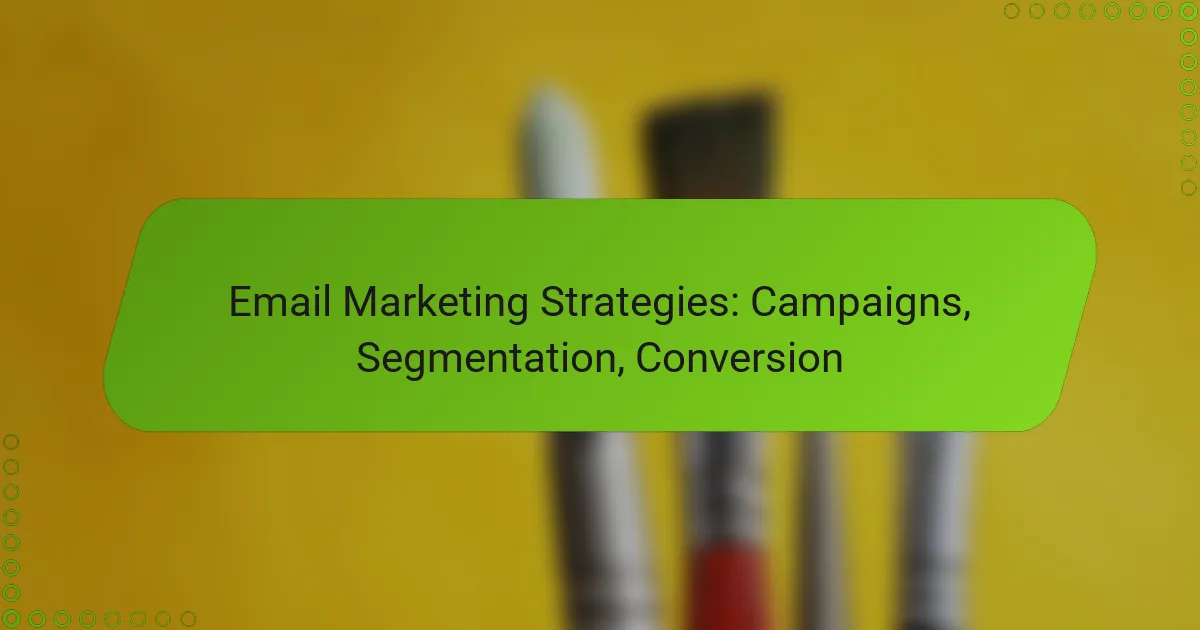Email marketing is a powerful tool for businesses looking to connect with their audience and drive sales. By employing effective strategies such as segmentation, tailored content, and clear calls-to-action, companies can significantly improve engagement and conversion rates. Focusing on automation and testing further enhances the effectiveness of campaigns, ensuring that messages resonate with the right recipients.
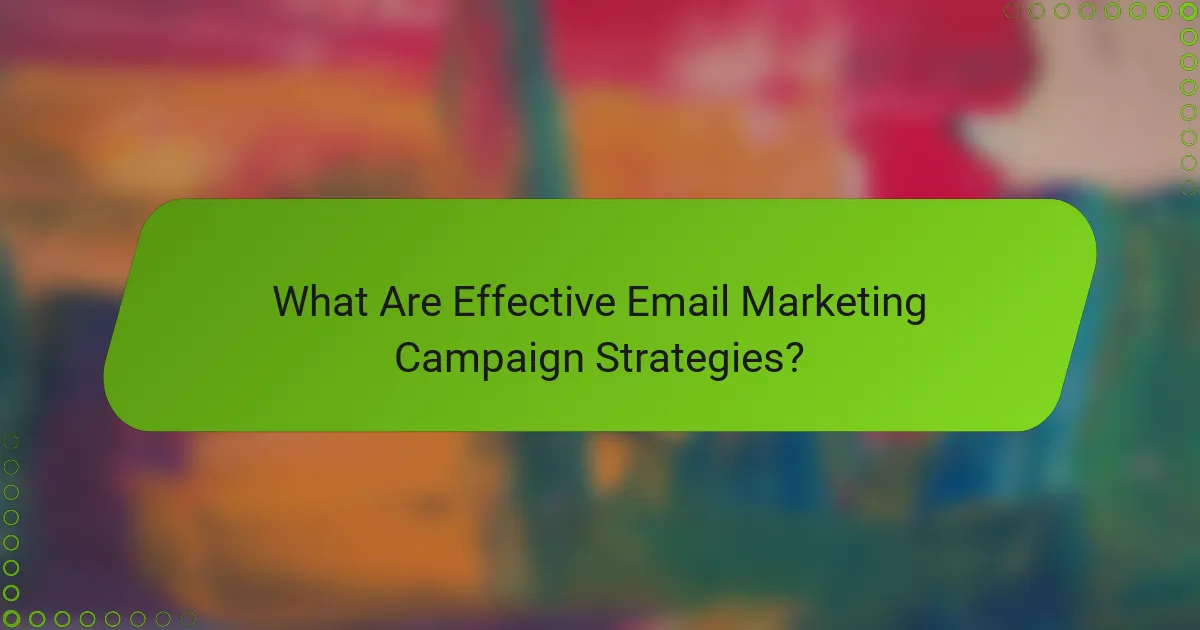
What Are Effective Email Marketing Campaign Strategies?
Effective email marketing campaign strategies focus on engaging your audience through tailored content, automation, and testing. By implementing these strategies, businesses can enhance customer relationships, improve conversion rates, and drive sales.
Personalized content
Personalized content involves tailoring emails to individual recipients based on their preferences, behaviors, and demographics. This can include using their name, recommending products based on past purchases, or sending targeted offers. Personalization can significantly increase open rates and conversions, making it a crucial strategy.
To implement personalized content, segment your email list into groups based on shared characteristics. Tools like dynamic content can help automate this process, ensuring that each recipient receives relevant information.
Automated workflows
Automated workflows streamline your email marketing by sending targeted messages based on specific triggers, such as user actions or important dates. For example, you can set up a welcome series for new subscribers or reminders for abandoned shopping carts. This not only saves time but also ensures timely communication with your audience.
To create effective automated workflows, map out customer journeys and identify key touchpoints. Use email marketing platforms that offer robust automation features to help you implement these workflows efficiently.
Seasonal promotions
Seasonal promotions leverage holidays and events to create timely and relevant email campaigns. These promotions can include discounts, special offers, or themed content that resonates with your audience during specific times of the year. For instance, a summer sale or holiday gift guide can attract attention and drive sales.
When planning seasonal promotions, consider your audience’s interests and the timing of your campaigns. Use countdown timers in your emails to create urgency and encourage immediate action.
Engaging subject lines
Engaging subject lines are essential for capturing attention and encouraging recipients to open your emails. A compelling subject line should be concise, intriguing, and relevant to the content of the email. Experiment with different styles, such as questions, exclamations, or personalization, to see what resonates best with your audience.
A good rule of thumb is to keep subject lines under 50 characters to ensure they display well on mobile devices. Avoid using all caps or excessive punctuation, as these can trigger spam filters.
A/B testing
A/B testing, or split testing, involves comparing two versions of an email to determine which performs better. This can include testing different subject lines, content layouts, or calls to action. By analyzing the results, you can make data-driven decisions to optimize future campaigns.
To conduct effective A/B tests, ensure that you test only one variable at a time and use a sufficiently large sample size. Aim for a testing duration of at least a few days to gather meaningful data before making changes based on the results.
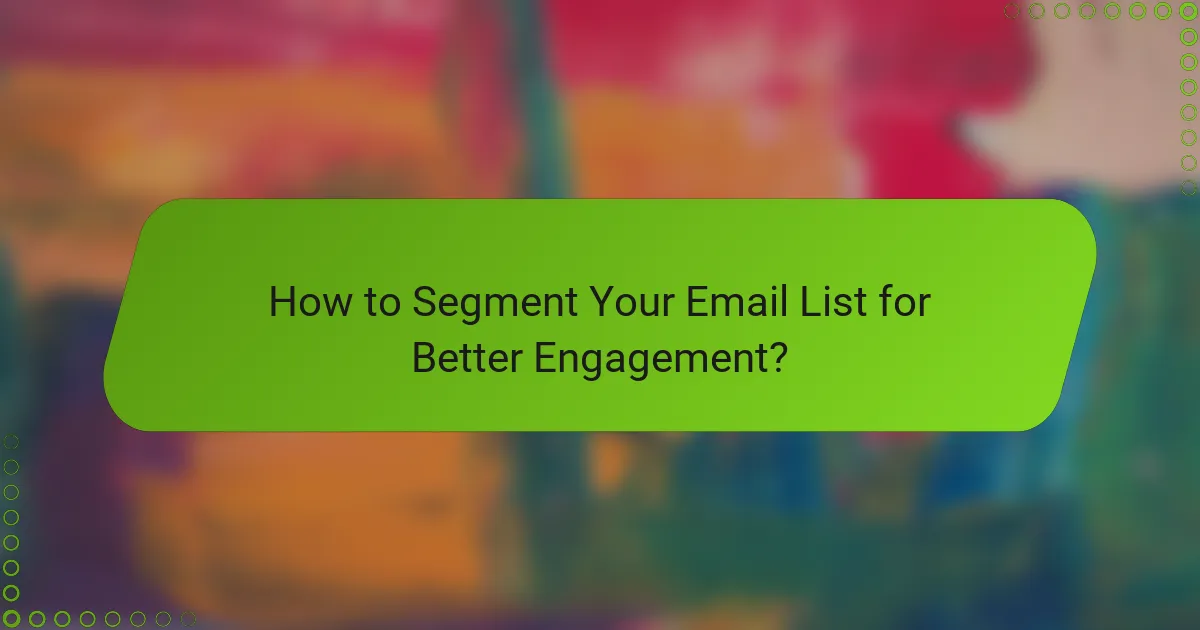
How to Segment Your Email List for Better Engagement?
Segmenting your email list enhances engagement by allowing you to tailor messages to specific groups based on shared characteristics. This targeted approach increases open rates, click-through rates, and overall campaign effectiveness.
Demographic segmentation
Demographic segmentation involves categorizing your email list based on characteristics such as age, gender, income, and education level. This method helps you create content that resonates with specific groups, improving relevance and engagement.
For example, a luxury brand may target high-income individuals with exclusive offers, while a student-focused service might appeal to younger audiences with budget-friendly promotions. Consider using surveys or registration forms to gather demographic data.
Behavioral segmentation
Behavioral segmentation focuses on how subscribers interact with your emails and website. This includes tracking actions like email opens, clicks, and purchases, allowing you to tailor messages based on user behavior.
For instance, you can create campaigns for users who frequently open emails but rarely click through, offering them incentives to engage further. Alternatively, target customers who have made recent purchases with follow-up emails suggesting complementary products.
Geographic segmentation
Geographic segmentation divides your email list based on location, which can significantly impact marketing strategies. Understanding regional preferences and cultural differences allows for more relevant content and offers.
For example, a restaurant chain might send different promotions to subscribers in urban areas compared to those in rural locations. Additionally, consider local events or holidays when crafting your messages to increase relevance.
Purchase history segmentation
Purchase history segmentation categorizes subscribers based on their previous buying behavior. This approach enables you to send personalized recommendations and targeted offers that align with past purchases.
For instance, if a customer frequently buys fitness products, you can send them emails featuring new workout gear or health-related content. This targeted strategy not only boosts engagement but also encourages repeat purchases.
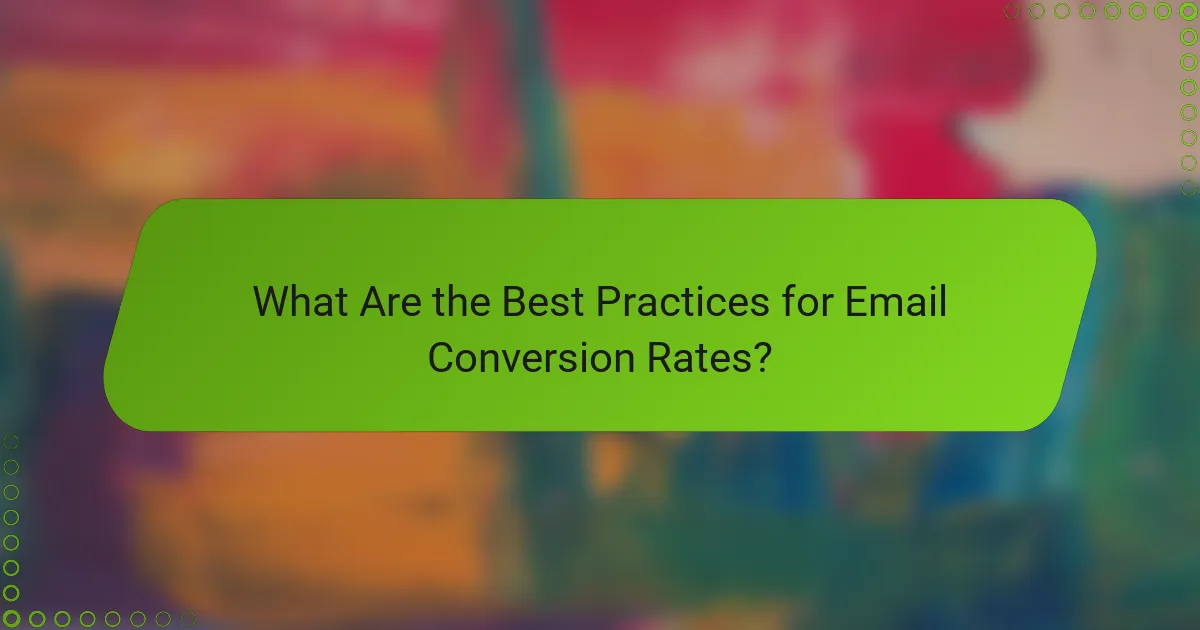
What Are the Best Practices for Email Conversion Rates?
To achieve high email conversion rates, focus on clear calls-to-action, mobile optimization, and ensuring your landing pages align with your email content. Implementing these best practices can significantly enhance user engagement and drive conversions.
Clear call-to-action
A clear call-to-action (CTA) is essential for guiding recipients toward the desired action, whether it’s making a purchase or signing up for a newsletter. Use concise, action-oriented language and ensure the CTA stands out visually in your email.
Position your CTA prominently, ideally above the fold, and consider using contrasting colors to make it more noticeable. Test different phrases and designs to see which ones resonate best with your audience.
Mobile optimization
With a significant portion of emails being opened on mobile devices, optimizing your emails for mobile is crucial. Ensure that your email design is responsive, meaning it adjusts seamlessly to different screen sizes.
Keep your content concise and use larger fonts for readability. Test your emails on various devices and email clients to ensure a consistent experience, as this can greatly impact your conversion rates.
Landing page alignment
Your landing page should match the message and design of your email to create a cohesive user experience. If your email promotes a specific product or offer, the landing page should reflect that same product or offer prominently.
Ensure that the transition from email to landing page is smooth, with consistent branding and messaging. This alignment helps build trust and can lead to higher conversion rates, as users are more likely to complete the desired action when they feel they are in the right place.
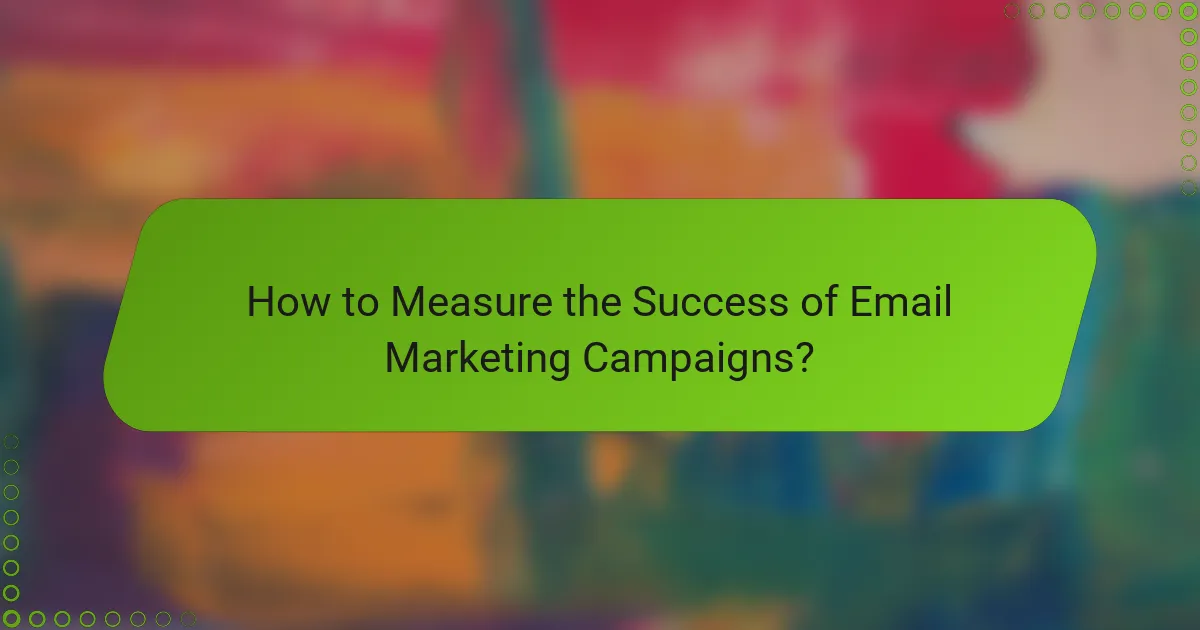
How to Measure the Success of Email Marketing Campaigns?
Measuring the success of email marketing campaigns involves analyzing key performance indicators (KPIs) that reflect engagement and conversion. Focus on metrics such as open rates, click-through rates, conversion rates, and return on investment to gauge effectiveness and make informed adjustments.
Open rates
Open rates indicate the percentage of recipients who opened your email compared to the total number sent. A typical open rate ranges from 15% to 25%, depending on the industry. To improve open rates, consider optimizing subject lines and sending times.
Track open rates using your email marketing platform’s analytics. A/B testing different subject lines can help identify what resonates best with your audience, leading to higher engagement.
Click-through rates
Click-through rates (CTR) measure the percentage of recipients who clicked on one or more links within your email. A good CTR generally falls between 2% and 5%. To enhance CTR, ensure your content is relevant and includes clear calls to action.
Utilize engaging visuals and concise text to encourage clicks. Segmenting your audience can also lead to more tailored content, which often results in better click-through performance.
Conversion rates
Conversion rates reflect the percentage of email recipients who completed a desired action, such as making a purchase or signing up for a webinar. Typical conversion rates can vary widely, often ranging from 1% to 5%. To boost conversions, align your email content with landing pages for a seamless user experience.
Incorporating urgency or limited-time offers can motivate recipients to act quickly. Regularly review your conversion metrics to identify trends and optimize future campaigns.
Return on investment
Return on investment (ROI) measures the profitability of your email marketing efforts. To calculate ROI, subtract the total costs of your campaign from the revenue generated, then divide by the campaign costs. A positive ROI indicates effective spending, while a negative ROI suggests the need for reevaluation.
Monitor your ROI over time to assess the long-term value of your email marketing strategy. Consider factors like customer lifetime value and retention rates to gain a comprehensive understanding of your campaign’s financial impact.
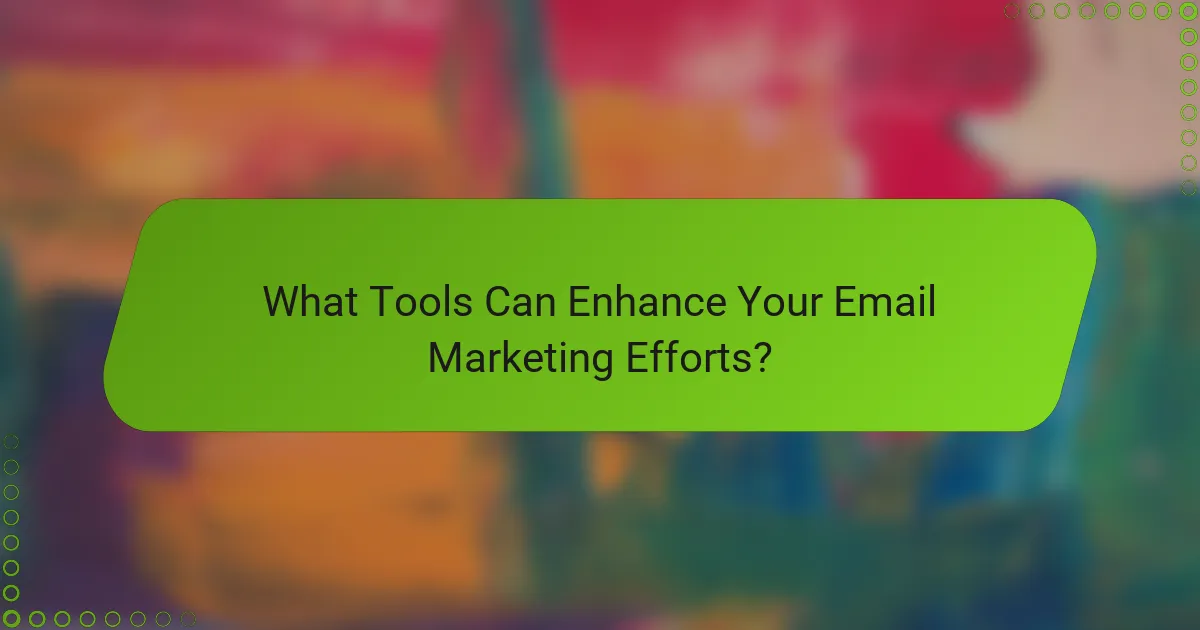
What Tools Can Enhance Your Email Marketing Efforts?
Utilizing the right tools can significantly improve your email marketing campaigns by streamlining processes, enhancing segmentation, and boosting conversion rates. Key platforms like Mailchimp, Constant Contact, and HubSpot offer various features tailored to different marketing needs.
Mailchimp
Mailchimp is a popular email marketing platform known for its user-friendly interface and robust features. It offers customizable templates, automation options, and detailed analytics, making it suitable for both beginners and experienced marketers.
One of its standout features is the ability to segment your audience based on behavior and demographics, allowing for targeted campaigns. Mailchimp’s free tier is a great starting point for small businesses, but costs can rise as your list grows or if you need advanced features.
Constant Contact
Constant Contact focuses on providing excellent customer support and a variety of marketing tools. It includes features like list segmentation, social media integration, and event management, which can be beneficial for businesses looking to promote events through email.
This platform also offers a 60-day free trial, allowing users to explore its capabilities before committing. However, its pricing can be higher compared to other options, especially for larger lists, so it’s essential to evaluate your budget and needs before choosing this tool.
HubSpot
HubSpot is an all-in-one marketing platform that includes email marketing as part of its broader suite of tools. It excels in automation and CRM integration, making it ideal for businesses that want to align their email campaigns with overall marketing strategies.
With HubSpot, you can create highly personalized emails based on user interactions and lifecycle stages. While it offers a free tier, advanced features come at a premium, which may be a consideration for small businesses or startups looking to manage costs effectively.
